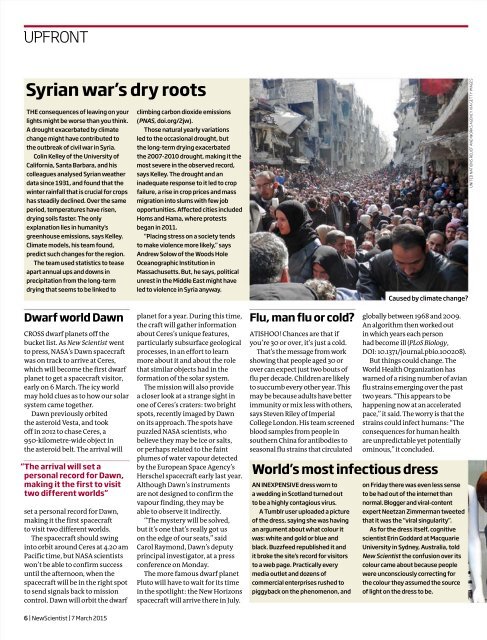New Scientist Magazine - No. 3011
New Scientist Magazine - No. 3011
New Scientist Magazine - No. 3011
You also want an ePaper? Increase the reach of your titles
YUMPU automatically turns print PDFs into web optimized ePapers that Google loves.
UPFRONTSyrian war’s dry rootsTHE consequences of leaving on your climbing carbon dioxide emissionslights might be worse than you think. (PNAS, doi.org/2jw).A drought exacerbated by climateThose natural yearly variationschange might have contributed to led to the occasional drought, butthe outbreak of civil war in Syria. the long-term drying exacerbatedColin Kelley of the University of the 2007-2010 drought, making it theCalifornia, Santa Barbara, and his most severe in the observed record,colleagues analysed Syrian weather says Kelley. The drought and andata since 1931, and found that the inadequate response to it led to cropwinter rainfall that is crucial for crops failure, a rise in crop prices and masshas steadily declined. Over the same migration into slums with few jobperiod, temperatures have risen, opportunities. Affected cities includeddrying soils faster. The onlyHoms and Hama, where protestsexplanation lies in humanity’sbegan in 2011.greenhouse emissions, says Kelley. “Placing stress on a society tendsClimate models, his team found, to make violence more likely,” sayspredict such changes for the region. Andrew Solow of the Woods HoleThe team used statistics to tease Oceanographic Institution inapart annual ups and downs inMassachusetts. But, he says, politicalprecipitation from the long-term unrest in the Middle East might havedrying that seems to be linked to led to violence in Syria anyway.–Caused by climate change?–UNITED NATIONS RELIEF AND WORKS AGENCY VIA GETTY IMAGESDwarf world DawnCROSS dwarf planets off thebucket list. As <strong>New</strong> <strong>Scientist</strong> wentto press, NASA’s Dawn spacecraftwas on track to arrive at Ceres,which will become the first dwarfplanet to get a spacecraft visitor,early on 6 March. The icy worldmay hold clues as to how our solarsystem came together.Dawn previously orbitedthe asteroid Vesta, and tookoff in 2012 to chase Ceres, a950-kilometre-wide object inthe asteroid belt. The arrival will“The arrival will set apersonal record for Dawn,making it the first to visittwo different worlds”set a personal record for Dawn,making it the first spacecraftto visit two different worlds.The spacecraft should swinginto orbit around Ceres at 4.20 amPacific time, but NASA scientistswon’t be able to confirm successuntil the afternoon, when thespacecraft will be in the right spotto send signals back to missioncontrol. Dawn will orbit the dwarfplanet for a year. During this time,the craft will gather informationabout Ceres’s unique features,particularly subsurface geologicalprocesses, in an effort to learnmore about it and about the rolethat similar objects had in theformation of the solar system.The mission will also providea closer look at a strange sight inone of Ceres’s craters: two brightspots, recently imaged by Dawnon its approach. The spots havepuzzled NASA scientists, whobelieve they may be ice or salts,or perhaps related to the faintplumes of water vapour detectedby the European Space Agency’sHerschel spacecraft early last year.Although Dawn’s instrumentsare not designed to confirm thevapour finding, they may beable to observe it indirectly.“The mystery will be solved,but it’s one that’s really got uson the edge of our seats,” saidCarol Raymond, Dawn’s deputyprincipal investigator, at a pressconference on Monday.The more famous dwarf planetPluto will have to wait for its timein the spotlight: the <strong>New</strong> Horizonsspacecraft will arrive there in July.Flu, man flu or cold?ATISHOO! Chances are that ifyou’re 30 or over, it’s just a cold.That’s the message from workshowing that people aged 30 orover can expect just two bouts offlu per decade. Children are likelyto succumb every other year. Thismay be because adults have betterimmunity or mix less with others,says Steven Riley of ImperialCollege London. His team screenedblood samples from people insouthern China for antibodies toseasonal flu strains that circulatedglobally between 1968 and 2009.An algorithm then worked outin which years each personhad become ill (PLoS Biology,DOI: 10.1371/journal.pbio.100208).But things could change. TheWorld Health Organization haswarned of a rising number of avianflu strains emerging over the pasttwo years. “This appears to behappening now at an acceleratedpace,” it said. The worry is that thestrains could infect humans: “Theconsequences for human healthare unpredictable yet potentiallyominous,” it concluded.World’s most infectious dressAN INEXPENSIVE dress worn toa wedding in Scotland turned outto be a highly contagious virus.A Tumblr user uploaded a pictureof the dress, saying she was havingan argument about what colour itwas: white and gold or blue andblack. Buzzfeed republished it andit broke the site’s record for visitorsto a web page. Practically everymedia outlet and dozens ofcommercial enterprises rushed topiggyback on the phenomenon, andon Friday there was even less senseto be had out of the internet thannormal. Blogger and viral-contentexpert Neetzan Zimmerman tweetedthat it was the “viral singularity”.As for the dress itself, cognitivescientist Erin Goddard at MacquarieUniversity in Sydney, Australia, told<strong>New</strong> <strong>Scientist</strong> the confusion over itscolour came about because peoplewere unconsciously correcting forthe colour they assumed the sourceof light on the dress to be.6 | <strong>New</strong><strong>Scientist</strong> | 7 March 2015


